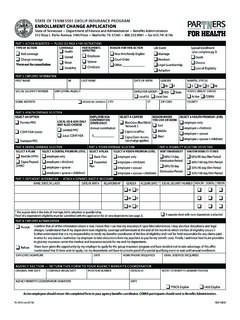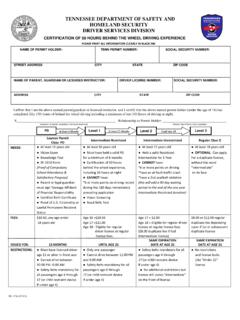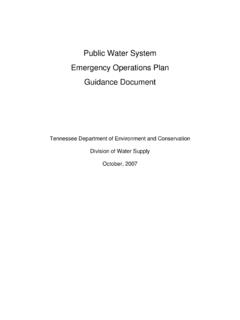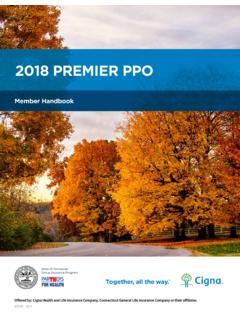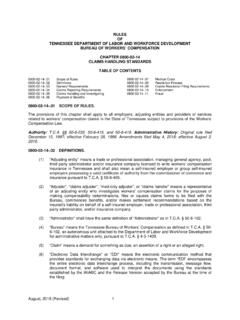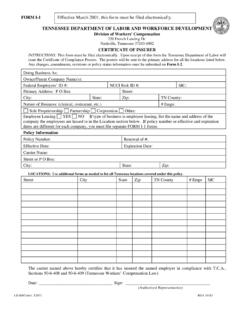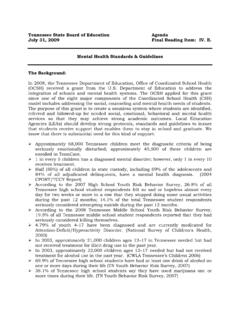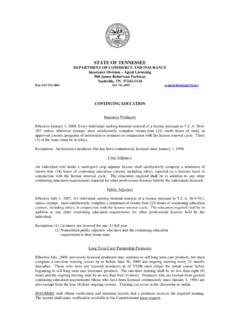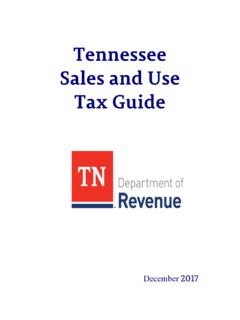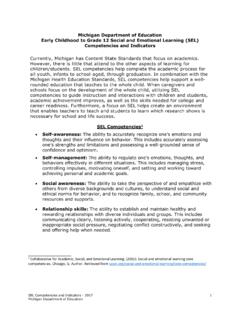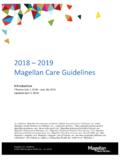Transcription of Children with Sexual Behavior Problems
1 EchappellTDMHSASR esearchTeam 02/25/2013 Page | 297 TDMHSAS BEST PRACTICE GUIDELINES Children with Sexual Behavior Problems Nationally, increasingly younger Children are coming to the attention of schools, courts, and social service agencies for Sexual Behavior Problems . While Tennessee law, state policy and mental health practice originally geared for adult offenders have been modified in part for minors who commit Sexual offenses, they do not differentiate between the Behavior of older minors and Children 12 and under that are experiencing Sexual behavioral Problems . However, research has shown that the assessment and treatment needs of Children ages 12 and under who have Sexual Behavior Problems are different from the assessment and treatment needs of adolescents who offend sexually. These differences must be taken into account when working with this population of Children . It is also important to note that problematic Sexual behaviors are only a small part of a child s Behavior and should not overshadow the view of the whole child.
2 The co-occurrence of victimization, trauma, and inappropriate Sexual Behavior by young Children accounts for an undeniably high number of cases of Children 12 and under who have Sexual Behavior Problems . However, not all Children who are sexually abused develop Sexual Behavior Problems , and not all Children who exhibit inappropriate Sexual Behavior are victims of childhood Sexual abuse. Therefore, inappropriate Sexual Behavior is not in and of itself diagnostic for a history of abuse or Sexual trauma. I. Definition of Children with Sexual Behavior Problems (CSBP) Child Sexual Behavior Problems are a set of functioning behaviors that fall outside acceptable societal norms. It is not a diagnostic category. Generally CSBP are defined as Children 12 and younger who initiate behaviors involving Sexual body parts that are developmentally inappropriate or potentially harmful. The intention and/or motivation of the behaviors may or may not be related to Sexual gratification.
3 These behaviors can be related to other factors such as curiosity, anxiety, imitation, attention seeking and/or self-calming. Sexual behaviors can be self-focused or involve other Children (Chaffin, M., Berliner, L., Block, R., Johnson, T. C., Friedrich, W. N., Louis, D. G., et al., 2006). Workgroup Members: Melissa L. Hoffman, PhD, University of Tennessee Center of Excellence for Children in State Custody Chairperson; Bonnie Beneke, LSCW, Tennessee Chapter of Children s Advocacy Centers; Tarah M. Kuhn, PhD, Vanderbilt University; and Melissa James, LCSW, University of Tennessee Health Science Center. echappellTDMHSASR esearchTeam 02/25/2013 Page | 298 II. Healthy vs. Problematic Sexual Behavior in Children When considering Sexual Behavior in Children under the age or 12 it is essential to distinguish between Behavior that is healthy and that which is considered problematic. Elements to consider include: Healthy Sexual play and exploration occurs spontaneously, intermittently, is mutual and non-coercive, not causing emotional distress.
4 Children engage in healthy Sexual Behavior because it is pleasant and they are curious. Sexual exploration is part of social development and information gathering about issues such as gender roles and behaviors, how bodies look alike and are different. Healthy Sexual Behavior is not a preoccupation. It generally comes out of a place of curiosity and exploration. Healthy Sexual Behavior does not usually involve advanced Sexual Behavior , such as intercourse or oral sex. When making distinctions between healthy and problematic Sexual Behavior it is important to be sensitive to developmental stage and cultural norms. Other factors to consider when distinguishing between healthy and problematic Behavior include: Frequency problematic Sexual Behavior occurs more frequently and is likely to interfere with normal childhood activities. Whether the child responds to correction by an adult. Generally, Children engaging in Sexual Behavior within the healthy range are responsive to redirection by adults.
5 It is important to note that Children with developmental disabilities may respond less quickly and therefore require additional redirection. When caught, Children engaging in healthy Sexual Behavior may show embarrassment, but usually not more negative emotions such as shame or anxiety. Age/developmental difference of Children . Use of force (self/others), intimidation or coercion. Presence of emotional distress. Interference with social development. Healthy Sexual Behavior Problematic Sexual Behavior III. Evaluation of CSBP Comes from a place of curiosity Behavior is spontaneous and mutual Behavior involves positive affect Behavior is responsive to redirection Involves Children in similar age/developmental range Low Frequency Behavior seems to be a preoccupation Engaging in advanced Sexual Behavior or knowledge Behavior seems planned/targeted or is coercive Behavior is emotionally distressing Behavior is unresponsive to redirection Inappropriate age/developmental range between Children Behavior is frequent or obsessive Behavior interferes with social development Behavior disrupts functioning echappellTDMHSASR esearchTeam 02/25/2013 Page | 299 For most Children with Sexual Behavior Problems , it is not necessary to conduct extensive, broad range assessments across many sessions.
6 It is important to determine at the very beginning whether the referral for an assessment of Sexual Behavior is appropriate. Evaluators can make this determination at the time of the referral by requesting collateral data to support existence of inappropriate Sexual Behavior and by helping the referring party to clarify referral questions. In gathering information for the assessment, focus should be on the following: Context, Social Ecology and Family: Assess the context of the Behavior in question as well as family and environmental issues that may be impacting the child. In cases where Children are in temporary living situations, the assessment should also focus on environmental needs in the permanent setting. Broad Psychological and Behavioral Status: Non- Sexual Problems including internalizing Problems , externalizing Problems , developmental issues and adverse environments often exist in Children with Sexual Behavior Problems . It is necessary to assess for these issues so that behaviors and presenting Problems can be prioritized.
7 Sexual Behavior and Contributing Factors: Attempt to identify circumstances under which Sexual Behavior Problems (SBP) seem to occur by obtaining a clear behavioral description of the Sexual behaviors in a chronological sequence. Some Children might engage in SBP when under stress, when depressed or frightened, when angry, or when reminded about past abuse. Others may engage in the Behavior in response to environmental triggers or when there is opportunity. Relevant information summarized above can be gathered using the following components: Review of background and collateral materials. This can include past psychological evaluations and school evaluations. Behavioral and psychosocial history as reported by caregiver. This may include: Developmental History; Family History: special attention paid to early development of relationships and environmental context, use of authority/discipline in the home, role of coercion and sexuality in family, manner of expressing affection and personal boundaries, parental history of psychological functioning and past trauma, and how supportive will family be in terms of treatment; Social History peer relations, social skills; Psychiatric/Treatment History; School History/Intellectual Functioning; and Medical History includes any current medications, significant medical conditions.
8 Child interview - focus on information gathering, including the child s understanding of the negative Sexual Behavior and laying the groundwork for addressing the SBP. The focus is not to get an admission and the interview should not include pressure the child to disclose. Administration of any of the following measures: echappellTDMHSASR esearchTeam 02/25/2013 Page | 300 The Child Sexual Behavior Inventory (CSBI) measures the frequency of both common and atypical behaviors, self-focused and other-focused behaviors, Sexual knowledge and level of Sexual interest The Child Sexual Behavior Checklist (CSBCL- 2nd revision) lists 150 behaviors related to sex and sexuality in Children , asks about environmental factors, gathers details about Sexual Behavior and lists 26 problematic characteristics of child Sexual Behavior . The Weekly Behavior Report (WBR) tracks week-to-week changes in general and Sexual Behavior among young Children .
9 Measures of Behavior and emotional symptoms, such as Child Behavior Checklists (CBCL), Behavior Assessment System for Children (BASC), and Trauma Symptom Checklist for Children (TSCC). Key differences between a psychosexual evaluation completed for an adolescent and an assessment for a child with Sexual Behavior Problems : There are typical components of a psychosexual that are not included in a child s assessment, such as Sexual history and certain risk measures. Standard recommendations such as no contact with Children 12 and under are not appropriate in assessments for Children . Children 12 and under should never be labeled as perpetrators or offenders in an assessment. Polygraphs or techniques designed to elicit a confession should never be used. It should be noted that level of risk is not considered a factor in CSBP in the same way it is with adolescent and adult Sexual offenders. CSBP are not considered Sexual offenders, regardless of whether they have been involved with the legal system or not.
10 Thus, risk to reoffend is not a consideration. Increasing structure and supervision in the home and addressing associated child and family treatment needs decreases the risk that is present for continued Sexual acting out. Evaluation Recommendations for Children with Sexual Behavior Problems : Recommendations should avoid broad statements; rather recommendations should focus on the individual child and family. Recommendations should be individualized based on the family circumstances and the age/developmental level of the child. Family issues to address should include needed services and supports for family members. Recommendations should address issues that are triggers for inappropriate Sexual Behavior , as well as issues related to boundary needs. Recommendations should address the existence of co-occurring conditions or other factors present in the child or family that require treatment attention. Specific recommendations related to safety in the home and community for the targeted child as well as any other Children in the home should be included.
